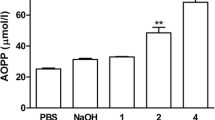Abstract
Oxidant stress leads to covalent oxidative modification of several plasma proteins, chief among which is fibrinogen. Aspirin can nonenzymatically acetylate fibrinogen's lysine residues, the functional groups most susceptible to oxidative modification. Because oxidation of fibrinogen may occur in the atheromatous environment, we studied the effects of oxidative modification on fibrinogen function and the consequences of acetylation by aspirin on fibrinogen's susceptibility to oxidation and functional properties. We exposed fibrinogen to Fe3+ ascorbate for 1 hour and showed that the carbonyl/protein molar ratio increased from 0.71 ± 0.18 to 2.86 ± 0.50 mol carbonyl/mol protein (P < 0.02) with an accompanying reduction in the α-helical content of the protein from 34% to 29%. Exposure of fibrinogen to aspirin led to acetylation of lysine residues and inhibition of oxidation. Oxidized fibrinogen was more readily able to form fibrin, and acetylation prevented this enhancement of clot formation. Oxidized fibrinogen also supported platelet aggregation better than did native, unoxidized fibrinogen, and acetylation of fibrinogen prior to oxidation prevented the enhanced platelet aggregation. Oxidized fibrinogen was less effective in stimulating plasminogen activation by tissue-type plasminogen activator (t-PA), with a catalytic efficiency that was reduced by 88% compared with native, unoxidized fibrinogen; acetylated fibrinogen, by contrast, enhanced plasminogen activation by t-PA with a catalytic efficiency that was increased by 18% compared with native, unoxidized fibrinogen (P < 0.05) and was increased by 51% compared with oxidized fibrinogen(P < 0.05). Acetylation prevented the reduction in catalytic efficiency induced by oxidation. These data show that oxidized fibrinogen manifests prothrombotic effects that can be prevented by acetylation and suggest that inhibition of fibrinogen oxidation may be an additional antithrombotic benefit of aspirin therapy.
Similar content being viewed by others
References
Stadtman ER. Oxidation of free amino acid residues in proteins by radiolysis and by metal-catalyzed reactions. Ann Rev Biochem 1993;62:797–821.
Stadtman ER. Protein oxidation and aging. Science 1992;257:1220–1224.
Stief TW, Marx R, Heimburger N. Oxidized fibrin(ogen) derivatives enhance the activity of tissue type plasminogen activator. Thromb Res 1989;56:221–228.
Shacter E, Williams JA, Lim M, Levine, L. Differential susceptibility of plasma proteins to oxidative modification: Examination by western blot immunoassay. Free Radic Biol Med 1994;7:429–437.
Witztum JL, Steinberg DL. Role of oxidized low-density lipoprotein in atherogenesis. J Clin Invest 1991;88:1785–1792.
Rabbani LE, Loscalzo J. Recent observations on the role of hemostatic determinants in the development of the atherothrombotic plaque. Atherosclerosis 1994;105:1–7.
Meade TW, Mellows S, Brozovic M, et al. Haemostatic function and ischaemic heart disease: Principal result of the Northwick Park Heart Study. Lancet 1986;2:533–537.
Ridker PM, Hennekens CH. Hemostatic risk factors for coronary heart disease. Circulation 1991;83:1098–1100.
Antiplatelet Trialists' Collaboration. Secondary prevention of vascular disease by prolonged antiplatelet treatment. Br Med J 1988;296:320–331.
Hennekens CH, Buring JE, Sandercock P, Collins R, Peto R. Aspirin and other antiplatelet agents in the secondary prevention of cardiovascular disease. Circulation 1989;80:749–756.
Roth GH, Majerus PW. The mechanism of the effect of aspirin on human platelets. I. Acetylation of a particulate fraction protein. J Clin Invest 1975;56:624–632.
Roth GJ, Siok CJ. Acetylation of the NH2-terminal serine of prostaglandin synthetase by aspirin. J Biol Chem 1978;253:3782–3784.
Moncada S, Vane JR. Pharmacology and endogenous roles of prostaglandin endoperoxides, thromboxane A2, and prostacyclin. Pharmacol Rev 1979;30:293–331.
Hanson Sr, Harker LA, Bjornsson, TD. Effects of platelet modifying drugs on arterial thromboembolism in baboons. Aspirin potentiates the antithrombotic actions of dipyridamole and sulfinpyrazone by mechanism(s) independent of platelet cyclooxygenase inhibition. J Clin Invest 1985;75:1591–1599.
Bjornsson TD, Schneider DE, Berger H Jr. Aspirin acetylates fibrinogen and enhances fibrinolysis. Fibrinolytic effect is independent of changes in plasminogen activator levels. J Pharmacol Exp Ther 1989;250:154–161.
Ezratty A, Freedman JE, Simon D, Loscalzo J. The antithrombotic effects of acetylation of fibrinogen by aspirin. J Vasc Med Biol 1994;5:152–159.
Okonkwo P, Sise HS. Effect of aspirin in vivo and in vitro on plasma cofactors of platelet aggregation. Thromb Diath Haemorrh 1971;25:279–287.
Pinckard RN, Hawkins D, Farr RS. In vitro acetylation of plasma proteins, enzymes and DNA by aspirin. Nature 1968;219:68–69.
Greenfield N, Fasman GD. Computed circular dichroism spectra for the evaluation of protein conformation. Biochemistry 1969;10:4108–4116.
Mao D, Wallace BW. Differential light scattering and absorption flattening optical effects are minimal in the circular dichroism spectra of unilamellar vesicles. Biochemistry 1984;23:2667–2673.
Chang CT, Wu C-SCC, Yang JT. Circular dichroic analysis of protein conformation: Inclusion of the β-turns. Anal Biochem 1978;91:13–31.
Brahms S, Brahms J. Determination of protein secondary structure in solution by vacuum ultraviolet circular dichroism. J Mol Biol 1980;138:149–178.
Sears DW, Beychok S. Circular Dichroism. In Leach SJ, ed. Physical Principles and Techniques of Protein Chemistry, Part C. New York: Academic Press,: 1993;445–593.
Ranby M. Studies on the kinetics of plasminogen activation by tissue plasminogen activator. Biochim Biophys Acta 1982;704:461–469.
Budzynski AZ. Difference in conformation of fibrinogen degradation products as revealed by hydrogen exchange and spectropolarimetry. Biochim Biophys Acta 1971;229:663–671.
Mihalyi E. Physicochemical studies of bovine fibrinogen. III. Optimal rotation of the native and denatured molecule. Biochim Biophys Acta 1965;102:487–499.
Author information
Authors and Affiliations
Rights and permissions
About this article
Cite this article
Upchurch, G.R., Ramdev, N., Walsh, M.T. et al. Prothrombotic Consequences of the Oxidation of Fibrinogen and their Inhibition by Aspirin . J Thromb Thrombolysis 5, 9–14 (1998). https://doi.org/10.1023/A:1008859729045
Issue Date:
DOI: https://doi.org/10.1023/A:1008859729045




